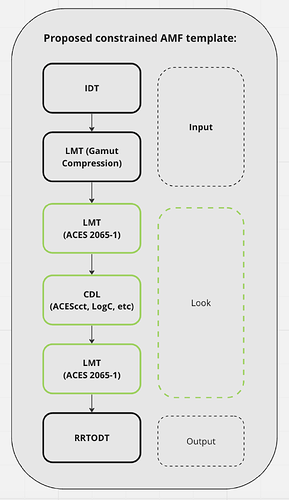Hello,
Following meeting #1, we would like to farm for feedback on the group’s proposed changes to AMF.
We are also open to any other ideas or feedback on AMF, if they are not listed here.
Please see page 2 and 3 of following google doc and comment as you wish:
AMF Revisions Group (google doc)
They are also pasted here if you have trouble viewing or commenting on the Google Doc:
Specification changes
- Look Transforms:
- Working Space for CDL: When defining a CDL as an LMT, the specs mandate the use of “From working color space”, but it seems that the “to working color space” isn’t mandatory?
- Is that intentional? Is it an error in the specs? Should we not mandate both transforms? or make both optionals?
- ColorCorrectionRef: there is an issue with the way AMF works with the ColorCorrectionRef connection within the current specs.
- There is not a way to connect to an external CCC file and to identify and link the file to the AMF and the CDL ID within it. There are a bunch of different ways we can tackle this issue down with minor specs changes.
- Applied Tag:
- “Applied” tag name: The “applied=False” has been confusing to every implementer, because it suggests that it “shouldn’t be applied”, rather than “it has not been applied to the image data”.
- “Applied” tag on RRT+ODT: In the current specs, it seems that the “applied” tag can be used for everything but the ODT and RRT transforms.
- It might just be a typo: in the UML diagram under 6.1.8 for outputTransform, there is no applied attribute. However, under the Types section 6.2.2.13 for aces:outputTransformType, there is an applied attribute.
- Output Transforms:
- Mandatory RRT/ODT: In the current specs, ODT and RRT are always required.
- This satisfies the original scope of AMF “how do I view this image?” However, I believe that in these last three years and after some real implementations, new use cases have arisen which require to create AMFs that do not require RRT ODTs (eg AMFs to automate VFX pulls - output EXRs without RRT/ODT applied).
- “Working Location” tag addition: In the current specs, there is no way to determine at which point of the pipeline the grading or VFX “work” is meant to be done, this is crucial for VFX work, as it’s hard to define the split line between pre/post compositing. This would also help with OCIO integration to distinguish the ‘reference space’ location. This could work in one or two ways:
- New element: add a (name is TBD) element
- New attribute for each transform: a <location=pre> and <location=post> attribute to determine the middle point.
Another item to review is an idea for a “constrained” AMF which we think will help with implementations and cover most use cases of AMF:
Our next meeting will likely be June 22nd so please try to review before then!
Thanks,
Chris
